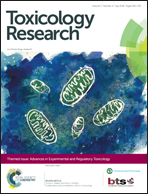Skin and respiratory chemical allergy: confluence and divergence in a hybrid adverse outcome pathway
Abstract
Sensitisation of the respiratory tract to chemicals resulting in respiratory allergy and allergic asthma is an important occupational health problem, and presents toxicologists with no shortage of challenges. A major issue is that there are no validated or, even widely recognised, methods available for the identification and characterisation of chemical respiratory allergens, or for distinguishing respiratory allergens from contact allergens. The first objective here has been review what is known (and what is not known) of the mechanisms through which chemicals induce sensitisation of the respiratory tract, and to use this information to construct a hybrid Adverse Outcome Pathway (AOP) that combines consideration of both skin and respiratory sensitisation. The intention then has been to use the construction of this hybrid AOP to identify areas of commonality/confluence, and areas of departure/divergence, between skin sensitisation and sensitisation of the respiratory tract. The hybrid AOP not only provides a mechanistic understanding of how the processes of skin and respiratory sensitisation differ, buy also a means of identifying areas of uncertainty about chemical respiratory allergy that benefit from a further investment in research.

- This article is part of the themed collections: Recent Review Articles and Advances in Experimental and Regulatory Toxicology


 Please wait while we load your content...
Please wait while we load your content...